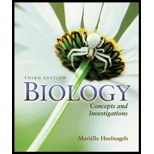
Concept explainers
To determine:
Why the evolution selects for males that mimic females, even though the chances of success is relatively low.
Concept introduction:
Australian giant cuttlefish (Sepia apama) show sexual dimorphism. The males and females of the species greatly differ from each other in appearance. Females have shorter arms and dark patches on a white background. On the other hand, the males have longer arms and are whiter.
The species has a sex ration of four males to one female, leading to fierce competition among males for fathering the offspring. The largest males mate with the females and guard them after insemination. The males fight with other males that try to inseminate the females. This behavior accounts for larger male’s reproductive success.
The smaller males use another behavioral strategy called deception. They disguise themselves as a female by hiding the arms and changing skin color. This behavior allows the smaller males to increase their chances of reproductive success.
Want to see the full answer?
Check out a sample textbook solution
Chapter 36 Solutions
Biology: Concepts and Investigations
- What are the Equality in the Sexes in Human Evolution? Why is this important to learn?arrow_forwardWhat are the characteristics of mate preference in sexual selection?arrow_forwardExplain how sexual selection might lead to a)sexual dimorphism and b) members of one sex (usually male) having traits that do not enhance their survivalarrow_forward
- Which of the following statements about inter- and intra-sexual selection is FALSE? O Males are typically the sex experiencing intrasexual selection because they are generally limited by access to mates, whereas females are generally limited by access to resources. Intersexual selection can explain the occurrence of extravagant display traits in males such as the ornate coloration in guppies. Males competing against each other to aquire the best nuptual gift is an example of intrasexual selection. O Either intersexual or intrasexual selection may occur within a population, but not both.arrow_forwardIntrasexual selection involves competition among one sex (typically males) for mating access to the other sex. Intersexual selection involves mate choice in which individuals from one sex (typically females) choose their mates from among individuals of the other sex. Imagine a group of males that is engaged in agonistic behavior, from which Male A emerges triumphant. Now imagine a female that is assessing all of the males that were involved in the fights, and chooses Male A. Explain why this situation shows how intrasexual and intersexual selection pressures are likely both at play in the trait selection.arrow_forwardQ1:Communication occurs when A) the stimulus-response reaction is altered. B) information flows in both directions. C) information is shared. D) an action by one individual alters the behavior of another. Q2. Bateman's principle states that, A) heritability of male traits is higher than for female traits. females experience greater variation in reproductive success than males. male and female reproductive success must be equal. males experience greater variation in reproductive success than femalesarrow_forward
- The northern red-legged frog, or Rana aurora, is found along the western coast from British Columbia to Northern California. Their typical breeding season lasts from January to March. The foothill yellow-legged frog, or Rana boylii, is found along the western coast from northern Oregon to central California. Their typical breeding season lasts from April to July. What mechanism might keep Rana aurora and Rana boylii from mating? anatomical isolation temporal isolation geographic isolation behavioral isolationarrow_forwardWhat sorts of studies would we undertake in order to confirm that human mating behaviors are truly driven by biological forces, e.g., evolutionary fitness, rather than cultural or societal advantages?arrow_forward|(A) A well trained alien biologist visiting earth would be able to tell that the mating system of gorillas is strongly polygynous and that of man's weakly polygynous. How could he/she/it tell this just by looking at gorillas and humans? (B) Is harem polygyny an ESS or have "cheater" behaviors evolved to exploit or exist within these systems? (C) If your answer was yes then describe a cheater behavior within a polygynous system.arrow_forward
- Which of the following sexual traits is LEAST likely to have evolved due to male-male competition for mates, also known as intraspecific sexual selection?a) Enlarged femurs that an insect uses to kick other malesb) Brushes on the tip of a dragonfly penis used to remove sperm of other malesc) Mate-guarding behavior of a warbler during the female’s fertile periodd) Elongated tails of the male swordtail fish used during courtshiparrow_forwardDescribe thoroughly the selective advantages and disadvantages organisms that reproduce sexually have over those that reproduce asexually, as well as the ramifications of mate choice on the traits present in species. The following questions could help answer the question above. What are the advantages of sexual reproduction? What are the disadvantages? How do traits selected by sexual selection and those selected by differential survival mix in an animal species? i.e. is it more important to mate or survive? Use specific examples to illustrate your point. Your answers should indicate an understanding of the mechanism behind natural selection. Propose a scenario where asexual reproduction would be favorable.arrow_forwardDefine sexual selection?arrow_forward

 Biology (MindTap Course List)BiologyISBN:9781337392938Author:Eldra Solomon, Charles Martin, Diana W. Martin, Linda R. BergPublisher:Cengage Learning
Biology (MindTap Course List)BiologyISBN:9781337392938Author:Eldra Solomon, Charles Martin, Diana W. Martin, Linda R. BergPublisher:Cengage Learning Human Heredity: Principles and Issues (MindTap Co...BiologyISBN:9781305251052Author:Michael CummingsPublisher:Cengage Learning
Human Heredity: Principles and Issues (MindTap Co...BiologyISBN:9781305251052Author:Michael CummingsPublisher:Cengage Learning


